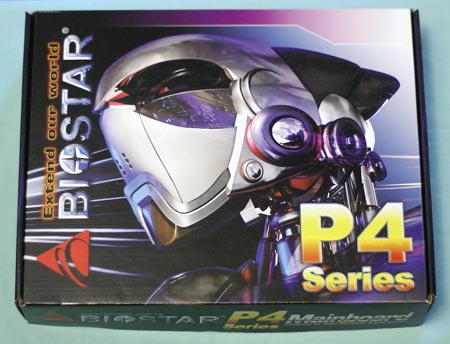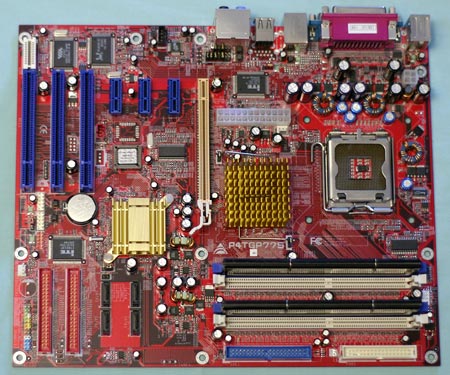915 Motherboard Roundup: Socket 775 for the Rest of Us
by Wesley Fink on December 7, 2004 12:25 AM EST- Posted in
- Motherboards
Biostar P4TGP 775: Features and Layout
| Biostar P4TGP 775 Motherboard Specifications | |
| CPU Interface | Socket 775 Pentium 4 (Prescott) |
| Chipset | Intel 915P/ICH6R |
| BUS Speeds | 200MHz to 255MHz (in 1MHz increments) |
| DDR2 Speeds | Auto, 333, 400 |
| PCI Speeds | 33.33, 36.36, 40.00 |
| Core Voltage | 1.25V to 1.60V in 0.0125V increments |
| DRAM Voltage | Default, 1.86V, 1.9V |
| NB (Northbridge) Voltage | Default, 1.86V, 1.9V |
| Memory Slots | Four 184-pin DDR 400 Slots Dual-Channel Unbuffered Memory to 4GB |
| Expansion Slots | 1 PCIe x16 Slot 3 PCIe x1 slot 3 PCI Slots SLR (Biostar Home Gateway) Slot |
| Onboard SATA/RAID | 4 SATA 150 drives by ICH6R Can be combined in RAID 0, 1, Intel Matrix |
| Onboard IDE/RAID | One Standard ATA100/66 (2 drives) plus 4 33/66/100 Drives by ITE8212 (RAID 0, 1, 0+1) |
| Onboard USB 2.0/IEEE-1394 | 8 USB 2.0 ports 2 IEEE 1394a FireWire Ports by VIA VT6307 |
| Onboard LAN | Gigabit PCI Ethernet by Realtek 8110S 4-port Router Card for SLR slot (Included) |
| Onboard Audio | CMI9880 (HD Audio) 8-Channel with Dolby Digital DDICE |
| Tested BIOS | 1.0 Award |
Over the years, Biostar has developed a reputation for delivering very solid boards at very attractive prices. The P4TGP 7875 is a good example of the value that Biostar delivers. Based on the 915P chipset, the Biostar still uses the preferred solution of the the ICH6R for the south bridge. This gives users the option of using the standout features of Intel Matrix RAID if they choose. Biostar also didn't compromise on audio, providing a High Definition audio solution that operates at 192kHz with 24bits, a greater than 95db Signal-to-Noise Ratio and Dolby Digital interactive Content Encoder (DDICE) compliance.

We appreciate the thinking that must have gone into these decisions and we think that Biostar made the right decision including these two trademark 915/925X features. Biostar also provides Gigabit LAN, but there is the compromise here in that the LAN resides on the PCI bus instead of the faster PCI Express. Biostar also provides Firewire ports and corrects the oversight of just 2 IDE devices with an added 4 IDE devices (total 6) with the ITE8212 controller. If you have been actually checking specs in the roundup, you will find that these features are missing from many boards which sell in the price range of the Biostar.
The Biostar also comes with a very interesting and unique feature called an RC8650 Router Card, which fits in a special SLR slot on the P4TGP 775. Most people these days have a router in their home system, and it is interesting to see Biostar including a router as part of their motherboard package. The WAN LAN connector plugs in the top port in the slot and there are 3 additional network connections available for more systems. An on-board router is an interesting idea to differentiate your motherboard design.

There is both good and bad in the Biostar P4TGP layout. Let's start with the good. The floppy and hard drive are in the preferred upper right edge location. This works best on most boards. The 4 SATA ports and 2 IDE connectors for 4 devices are also in reasonable locations at the lower right of the board. CD audio, if you need it, is around the midline of the board - in the PCIe slots area - which is OK. It would have been better above the slots. SPDIF in and out headers are in an unusual location between PCI2 x1 #3 and the first PCI slot. While the location looks a little strange, it works fine with accessory SPDIF brackets.
The most glaring fault in the Biostar layout, however, is a big one. The 24-pin ATX is in the middle of the board between the 915P north bridge and the rear IO. This is a horrible location that requires snaking the bulky 20/24-pin power cable around the CPU and hoping that it doesn't move and block air flow. The 12V 4-pin is better, near the top board edge, but the 20/24-pin really needs a new location on the Biostar board. Where other boards in the roundup seem to have some logic to their layout, the minor connectors on the Biostar seem to be sprinkled wherever there was room. The bulky cables except for power are OK, but things like the USB headers are in odd positions between slots.
We have complained in the past about boards where the memory slots are blocked by the video card. This is another board where you can't change memory without first removing the large video card. If you don't change memory very often, this will not be a problem, but if you frequently try out new memory, this tight fit will be a nuisance.
Overall, the decent layout of the rest of the bulky cables is marred by the horrible placement of the 20/24-pin power connector. Biostar would do themselves a favor by paying more attention to board layout in the future.
Asus P5GD2 Premium: Overclocking and Stress Testing
Biostar P4TGP 775: Overclocking and Stress Testing










26 Comments
View All Comments
Live - Tuesday, December 7, 2004 - link
Sorry Didn't see your reply before I posted Wesley.Sure there is some value to be had but not "outstanding". I still don't agree with you but I guess my mind is made up. Intel needs to come out with something new before I go back.
As a roundup it was very good reading tough. I can't wait for the next AMD roundup to hit AnandTech.
Live - Tuesday, December 7, 2004 - link
#12"The P5GD2 is an expensive motherboard, at about $240 on the web, but you can get almost all the same features in the P5GD2 Deluxe for about $50 less."
Thats expensive to me. Compare that to the 134.99 for the 939 Gold Editors Choice winner "MSI K8N Neo2 Platinum"
But thats not the point. If the 915P was substantially cheaper then a 939 system you might call it value for money but is it not. Mind you a 939 board is generally not cheap either but at least it delivers in comparison.
The CPU used in the review that hardly beat the much cheaper 3500+ had a max overclock of 14% and I bet you would find it hard to reach that high without the CPU overheating and start throttling http://www.anandtech.com/news/shownews.aspx?i=2345...
LGA775 CPUs does not offer great overclocking headroom compared to the much cheaper earlier Intel platforms or AMD for that matter. Sure they still overclock but nothing that we haven't seen before at higher cost and temperature. Again not what I would call outstanding.
Wesley Fink - Tuesday, December 7, 2004 - link
#11 - We just ran the 3500+ benchmarks in the same configuration this morning, and we do agree that the 3500+ is a particularly good value in performance for the dollar. However, the larger picture of prices of AMD CPUs compared to Intel show the Intel processors are a good, if not outstanding, value.Our conclusion was based on Anand's value analysis in the 3.46EE/1066 launch review at http://www.anandtech.com/cpuchipsets/showdoc.aspx?... There he compared the 3800+ at over $600 to a Intel 560 3.6GHz at about $450 and found the 3800+ the winner but probably not a big enough winner to justify the price premium for the 3800+. At that time, there was no 570 (3.8GHz) and the 3.6 was the fastest Intel CPU unless you considered the $1000+ Xeon-based EE processors. Price changes continue, and with them the value relationships do change.
A quick check of prices today shows
Intel 520(2.8GHz)- $160 AMD 2800+(754) - $128
Intel 530(3.0GHz)- $180 AMD A64 3000+ - $152
Intel 540(3.2GHz)- $220 AMD A64 3200+ - $194
Intel 550(3.4GHz)- $282 AMD A64 3400+ - $269
Intel 560(3.6GHz)- $455 AMD A64 3500+ - $270
Intel 570(3.8GHz)- $795 AMD A64 3800+ - $630
AMD A64 4000+ - $716
AMD A64 FX55 - $812
With current prices we would have to agree that there is really no great value advantage to Intel any more. But there is good value in the Intel processors from 2.8GHz (520) to 3.6GHz (560). Certainly the 4000+, at $80 less than the 570 and faster performance, and the FX55 at about the same price as 570 and significantly faster in most benchmarks, are better value at the top. But we still stand by Intel being good value in the middle.
deathwalker - Tuesday, December 7, 2004 - link
"outstanding value and performance for your buying dollar" ?????????? at $240 for a Mobo?..I guess I need to retake Economics 101...Bah...Intel just continues to shot themselves in the foot. A side note not related to this review..Dell must be deep inside of Intel's pocketbook with there contiued refusal to market AMD based products.danidentity - Tuesday, December 7, 2004 - link
#11 - 915P motherboards are not expensive. They are equal or cheaper in price than socket 939 A64 motherboards.LGA775 CPUs offer great overclocking headroom if paired with the right board. Intel CPUs have traditionally have had more OCing headroom than AMD chips. That still holds true, for the most part, today. Especially when talking about the low-end chips, like the 2.8GHz.
Live - Tuesday, December 7, 2004 - link
I'm sorry but I don't see the "outstanding value and performance for your buying dollar"Expensive Motherboards and CPUs with little overclocking headroom compared to the Athlon 64 competition. How does that translate to excellent value and performance? even the much cheaper 3500 comes out on top on most benchmarks.
Sure there are niche markets where the Intel platform excels but for the big majority of us AMD is where its at right now.
I don't think this review is in sync with your conclusion so either list some valid arguments for your point (Since its not there in the benchmarks) or edit the conclusion.
danidentity - Tuesday, December 7, 2004 - link
Wesley, thanks for including tests from a more comparable AMD CPU. Listening to your readers is always appreciated.Wesley Fink - Tuesday, December 7, 2004 - link
#4,#5,#6 - The Athlon 64 results with the FX55 were included for Reference, and not direct comparison. However you do make a good point.The closest A64 we had in the lab to a 3.6GHz 560 was the 3500+ based on the 90nm process. This should provide an advantage to the Intel 560. Since there are complaints here the FX55 is too high end, these new tests tilted toward Intel should balance the playing field. The 3500+ costs about $265 and the Intel 560 (3.6GHz) is about $455, so the 560 is about 70% more expensive than the 3500+.
The added 3500+ benchmarks were also an opportunity to test with the SAME ATI X800XT PCIe we used in benchmarking the 915 boards. Enjoy!
Color codes have been updated and there are now 3500+ results on the Gigabyte nForce4 with the ATI X800XT PCIe in all benchmarks.
Original plans were to include the Intel 570 in this roundup, but much of the testing was already done when the Intel 3.8GHz CPU was launched. This Intel 3.8 is priced at around $800, which is very close to the FX55. You can see how it compares to the FX55 in performance in Anand's launch article at http://www.anandtech.com/cpuchipsets/showdoc.aspx?...
CrystalBay - Tuesday, December 7, 2004 - link
It's a pity that all these 4 dimm slot, dual channelMB's have such a rough time doing it. Imagine trying
to run 4 1GB dimms in DC, this goes for ddr1 as well 2.
Glassmaster - Tuesday, December 7, 2004 - link
Now that Northwood and 865/875 are on the way out, only a fool would buy Intel.Glassmaster.